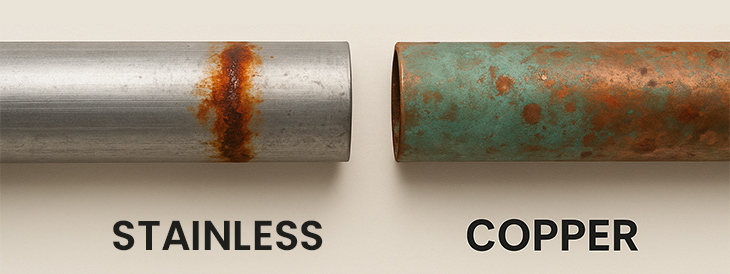In industries where strength, longevity, and aesthetics matter—especially in construction, plumbing, and manufacturing—the debate between stainless steel and copper remains ongoing. With corrosion resistance playing a pivotal role in material selection, businesses and contractors in the US and UK seek clarity on which metal stands the test of time. As sustainability and cost-effectiveness dominate purchasing decisions, understanding how stainless steel and copper behave under environmental stress becomes not just relevant, but essential.
Stainless Steel vs. Copper: Understanding Corrosion Resistance
Corrosion occurs when metals degrade due to exposure to moisture, oxygen, salts, or other chemicals. Stainless steel, known for its chromium-rich composition (minimum 10.5%), forms a passive oxide layer that self-heals, significantly reducing the rate of corrosion. In contrast, copper corrodes slowly and develops a green patina (copper oxide), which protects the metal but also affects its appearance and may not be suitable for all applications.
Stainless Steel’s Superior Resistance
Numerous studies, including those from the Nickel Institute and ASM International, show that stainless steel outperforms copper in environments with high humidity, salinity, and acidity. For example:
304 and 316 stainless steel are commonly used in coastal and industrial environments for their high corrosion resistance.
Stainless steel piping systems in food, pharmaceutical, and chemical industries last longer due to their inert, non-reactive nature.
For infrastructure projects in places like New York or London—where weather extremes and pollution are concerns—stainless steel’s low maintenance and long lifecycle make it a preferred material.
Copper’s Unique Advantages and Limitations
While copper is inherently corrosion-resistant, especially in freshwater systems, it is not immune. Acidic or soft water can leach copper ions, leading to pipe deterioration over time. Additionally, copper reacts with sulfur compounds and industrial pollutants, causing corrosion that can weaken structural integrity.
However, copper has natural antimicrobial properties and excellent thermal conductivity, making it suitable for specific use cases like HVAC systems, roofing, and electrical wiring. Its patina is also considered aesthetically pleasing in architectural designs, but it may not suit sterile or hygienic environments where rust-like discoloration is undesirable.
Future Trends and Material Preferences in Industrial Applications
As industries transition toward sustainable, high-performance materials, the demand for stainless steel is on the rise. Its recyclability, durability, and reduced environmental impact make it a material of choice in green construction and modern engineering.
Emerging technologies such as automated fabrication, laser welding, and precision cutting make stainless steel even more adaptable, driving down costs and increasing availability across the US and UK markets.
For manufacturers, fabricators, and contractors seeking corrosion-resistant materials that ensure long-term ROI, stainless steel offers a more predictable performance curve than copper, especially in aggressive environments.
Conclusion: Making the Right Material Choice
While both stainless steel and copper offer corrosion resistance, stainless steel consistently outperforms copper in harsh conditions, making it ideal for industries where durability, hygiene, and aesthetics are paramount.
At Nakoda Steel Industry, we provide high-quality stainless steel products engineered for performance and longevity. Whether you’re managing a large infrastructure project or a precision-based manufacturing line, investing in corrosion-resistant stainless steel could mean less downtime, lower maintenance, and greater value.
Looking to upgrade your next project with superior corrosion-resistant materials? Contact Nakoda Steel Industry to explore the perfect stainless steel solution.


